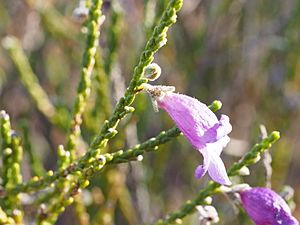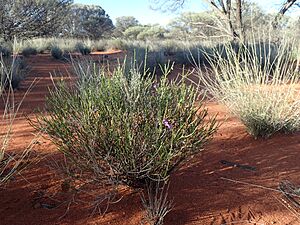Eremophila homoplastica facts for kids
Quick facts for kids Eremophila homoplastica |
|
|---|---|
 |
|
| Eremophila homoplastica leaves and flowers | |
| Scientific classification | |
| Genus: |
Eremophila (plant)
|
| Species: |
homoplastica
|
| Synonyms | |
|
Pholidia homoplastica S.Moore |
|
Eremophila homoplastica is a pretty flowering plant that belongs to the figwort family. It grows only in Western Australia, which means it is endemic there. This plant is a small shrub with many thin, tangled branches, tiny leaves, and lovely purple or lilac-coloured flowers.
Contents
About the Plant
Eremophila homoplastica is a small shrub that usually grows less than 0.4 metres (about 1.3 feet) tall. It has many thin, tangled branches.
Leaves
The leaves of this plant are very small. They are about 1.7 to 4.5 millimetres (0.07 to 0.18 inches) long and 1.0 to 1.5 millimetres (0.04 to 0.06 inches) wide. They are shaped like an oblong and have a bumpy, wrinkled surface. The leaves are attached to the branches in an alternating pattern, meaning they don't grow directly opposite each other.
Flowers
The flowers grow one by one where the leaves meet the branches. Each flower sits on a short stalk, about 2 to 3 millimetres (0.08 to 0.12 inches) long.
There are five green, egg-shaped sepals that protect the flower bud. These sepals are thick and pointed, about 2 to 3 millimetres long, and covered with short white hairs.
The petals are joined together at their base, forming a tube. This tube is about 9.5 to 13 millimetres (0.37 to 0.51 inches) long. The flowers are usually lilac or purple, with lighter lilac tips on the petal lobes. Inside the tube, there are faint spots. The outside of the flower tube and the petal tips have scattered hairs, but the inside of the petal tips is smooth. The inside of the tube is woolly.
The four stamens, which are the parts that produce pollen, are completely hidden inside the petal tube.
Flowering and Fruits
Eremophila homoplastica usually flowers from June to September. After the flowers, the plant produces fruits. These fruits are fleshy and can be reddish to blackish-brown. They are oval-shaped or almost round, smooth, and shiny. Each fruit is about 4.5 to 6.2 millimetres (0.18 to 0.24 inches) long.

Plant Names
Eremophila homoplastica was first officially described in 1899 by a scientist named Spencer Le Marchant Moore. He first called it Pholidia homoplastica. Later, in 1931, another botanist named Charles Gardner changed its name to Eremophila homoplastica.
The second part of its name, homoplastica, comes from ancient Greek words. Homo- means "alike," and plasticos means "fit for moulding." This name might refer to how similar its growth and leaf shape are to another plant called E. gibbifolia.
Where It Grows
This plant grows in many different types of soil. You can often find it in mulga woodlands. It is common in areas between Sandstone and Lake Rason in Western Australia. These areas include the Great Victoria Desert and Murchison regions.
Conservation Status
The Western Australian Government's Department of Parks and Wildlife has classified Eremophila homoplastica as "not threatened." This means the plant is not currently in danger of disappearing.
Growing This Plant
Eremophila homoplastica is not often grown in gardens, especially in southern Australia. It can be a bit tricky to grow.
You can start new plants from cuttings (small pieces of the plant) or by grafting (joining parts of two plants together). It grows best in soil that drains water well and in a sunny spot. This plant can handle dry conditions, but it needs to be protected from frost.

